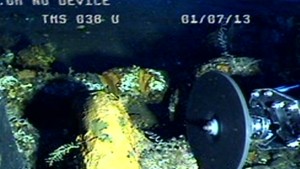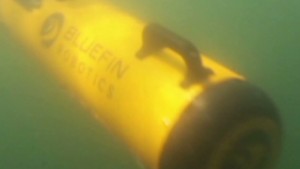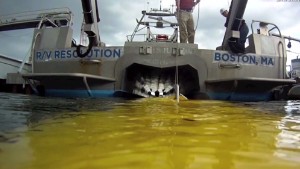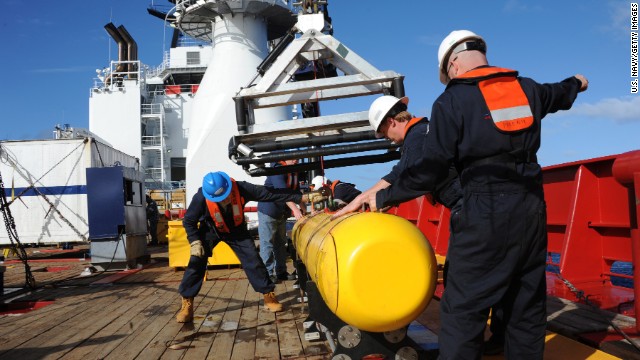April 16, 2014 -- Updated 1954 GMT (0354 HKT)
STORY HIGHLIGHTS
- NEW: Source says the Bluefin technical issue is a common one, nothing to worry about
- While the probe, called Bluefin-21, was on the surface, data from it were collected
- Families ask about Flight 370 technology and their right "to know the facts"
- They had 26 questions for authorities
(CNN) -- Families of some of the missing Malaysia Airlines Flight 370 passengers released a list of questions Wednesday that they said authorities have so far not answered.
Many of the 26 questions focus on technical issues involving emergency locator transmitters, or ELTs, and "black boxes." With an apparent in-depth understanding of how these work, the families ask about the specific technology on the missing plane.
ELTs are designed to activate after a crash and send a signal to a frequency monitored by air traffic controllers. "Black boxes," or voice and data recorders, could shed light on what went on in the plane's cockpit and other crucial flight information.
The families' final seven questions involve "protocol," including this: What did Malaysia Airlines do when the flight went missing?




The families also ask whether search and rescue teams have final results from searched areas, and whether the Malaysian government could specify the rights of family members "to know the facts of cases or the details of an incident."
The questions were posted on the social media site Weibo by a committee in Beijing representing some of the passengers' families. Some of the "questions" are requests that evidence be shared with them, including the flight's logbook and air traffic control audio.
Malaysia Airlines, for its part, has said it shares all the information it has with appropriate authorities.
In a video message this month, Hugh Dunleavy, the airline's commercial director, said the company shares the same "fundamental requirement" as the families: to find out what happened.
Malaysian authorities have come under criticism repeatedly for their handling of the investigation. But the government has insisted it's doing what it can to get to the bottom of what happened and support the families.
"We understand that it has been a difficult time for all the families. And we appreciate that many families want to see physical evidence before they will accept that MH370 ended in the southern Indian Ocean," acting Transport Minister Hishammuddin Hussein said at the end of March. "... The question that the families principally want answered, is the question we simply do not have the answer to -- namely, where their loved ones are, and where is MH370."
A week earlier, Hishammuddin made a pledge to the families: "We will do everything in our power to keep you informed."
Bluefin-21 resumes search
An underwater vessel searching for traces of the jet resurfaced Wednesday after 11 hours in the water. The vessel need to have a technical issue repaired.
Part of the equipment designed to help the Bluefin-21 move deeper and avoid seepage was low on oil. Officials replenished the supply and redeployed the vessel.
The Bluefin-21 has its electronics sealed in bottles so they are protected from salt water. As the probe moves deeper and the pressure increases the operating system pushes oil into these bottles. The oil counters the pressure and prevents salt water from seeping in. If oil fills the container, there's no space for salt water.
"In no way should this suggest that (the AUV) is not 'hardy' enough to be working at this depth. On the contrary, it is absolutely the best piece of equipment for the job we are doing," a source close to the operation said, adding that technical issues are common at great depths.
While on deck, its data were downloaded, the Australian Joint Agency Coordination Centre said.
"Bluefin-21 ... is currently continuing its underwater search," the center said in a statement. "Initial analysis of the data downloaded this morning indicates no significant detections."
This is the second setback for the underwater vehicle that's scanning the ocean floor for debris linked to Malaysia Airlines Flight 370.
In its first dive Monday, crews dipped it into the Indian Ocean on what was expected to be a 20-hour deployment. It returned less than eight hours later after it exceeded its maximum dive depth.



"What Bluefin did was it detected that it was moving near its maximum depth, sending signals back to its operators," said Mike Dean, the U.S. Navy deputy director for salvage and diving.
"After the two signals, which was deeper than what we anticipated, the operators decided to bring it back and reassess the boundaries in which they were operating it," he said.
It found no debris during its shortened scanning session.
Searchers lowered it toward the ocean floor for a second dive Tuesday, and it resurfaced short of its 24-hour mission because of technical issues. It then went down again.
24-hour mission
Bluefin-21 takes two hours to get near the ocean floor and another two hours to return to the surface. It aims to map the ocean floor for 16 hours to retrieve data, which then take four hours to analyze.
The vessel searches maximum depths of 4,500 meters (14,764 feet), and before the technical interruption, it was scheduled to complete its second dive about 10 a.m. ET, a source said. It's unclear when it will finish its current mission following the resurfacing.
"We have known a long time that especially the recent search area, the new search area they are looking at now, there's a lot of debris there because it is close to what we call the garbage patch, and that's where all of the garbage accumulates," said Erik Van Sebille, a physical oceanographer at University of New South Wales.
'Garbage patch'
"There are five in each basin and one in the Indian Ocean. Everything that has been thrown in the ocean in the last 50 years and still floating is somewhere in this garbage patch."
Malaysia Airlines Flight 370 vanished on March 8 with 239 people aboard after taking off from Kuala Lumpur, Malaysia, bound for Beijing.
With no debris found after weeks of searches and no possible pings from the plane's "black boxes" detected in a week, officials said it's time to focus the search underwater.
While air and sea surface searches continued Wednesday about 2,087 kilometers (1,297 miles) northwest of Perth, those searches are probably nearing an end.
"The air and surface search for floating material will be completed in the next two to three days in the area where the aircraft most likely entered the water," said retired Australian Air Chief Marshal Angus Houston, head of the Joint Agency Coordination Centre.
Fourteen planes, including three civilian jets, and 11 ships are involved in the search Wednesday.
It could take up to two months to scan the entire search area.


No comments:
Post a Comment